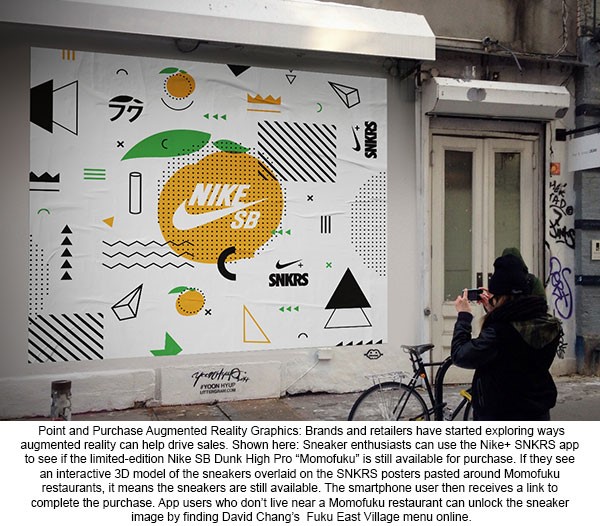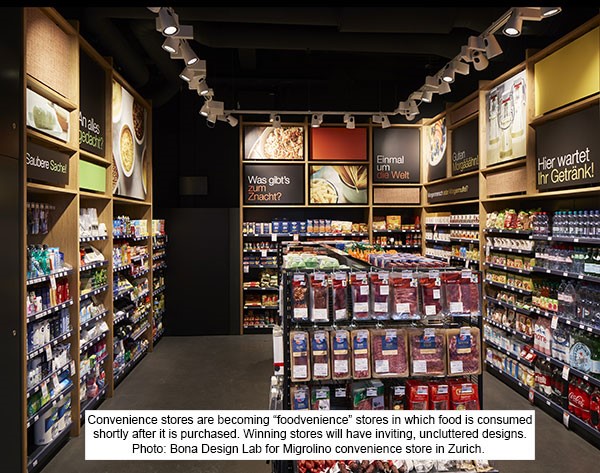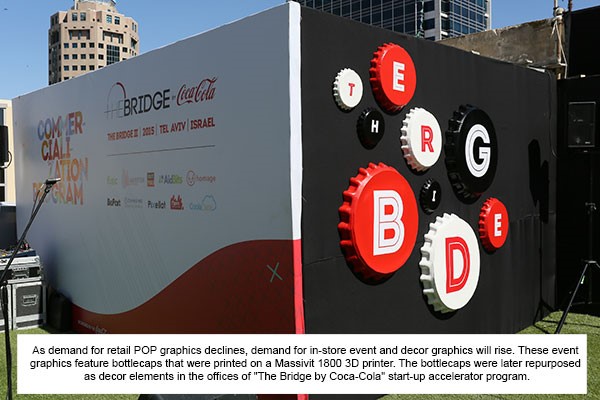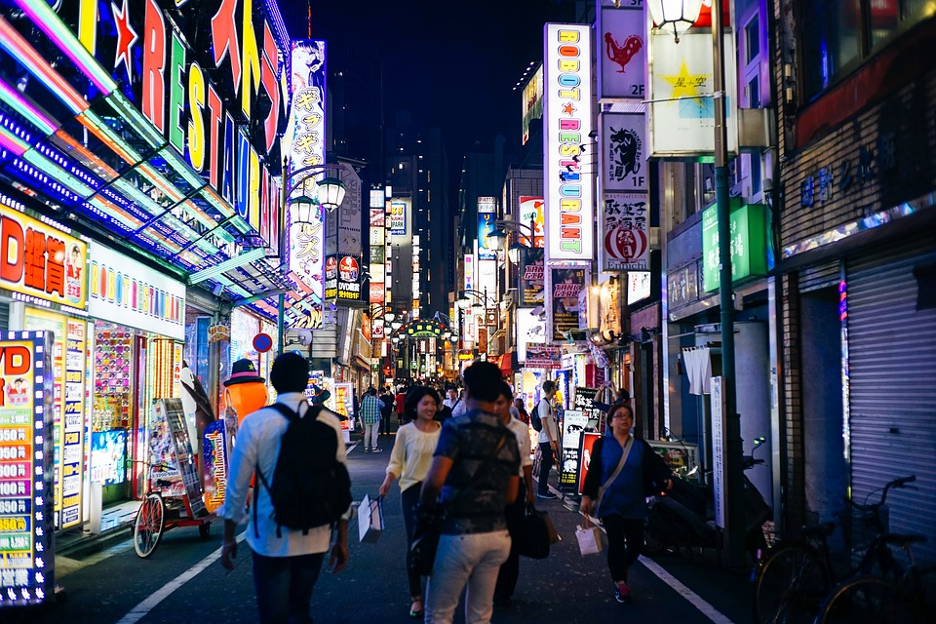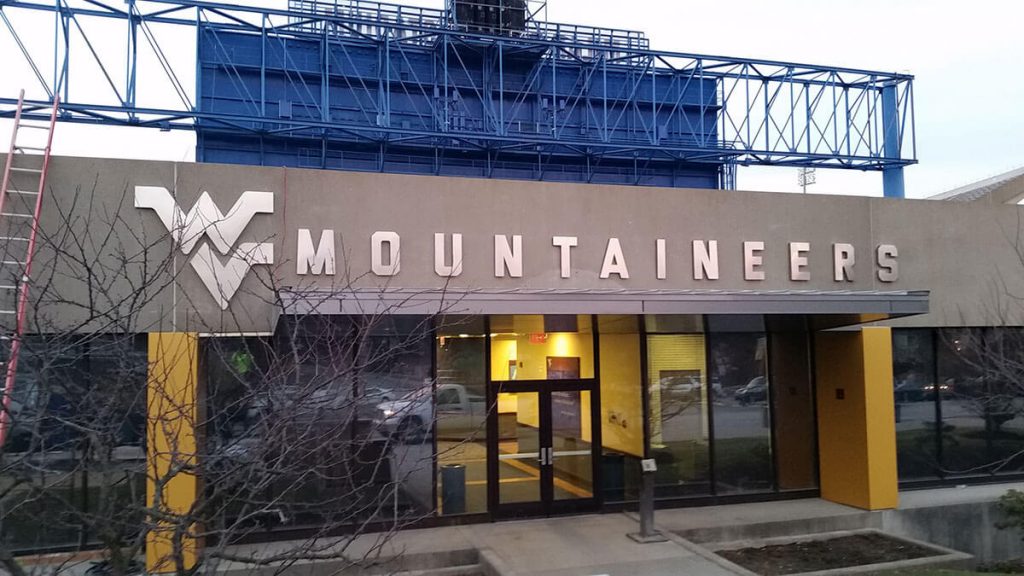The Changing Retail Landscape
by Eileen Fritsch
Retail Technology Adoption Has Been Slow
Brick-and-mortar stores have been experimenting with various in-store technologies for over a decade. The goal is to make in-store shopping more like online shopping: quick, convenient and personalized.
But until recently, there hasn’t been a sense of urgency to execute a broader strategy. Now there is.
Some technologies available for in-store use include interactive digital signage, self-service kiosks, interactive touchscreen mirrors in dressing rooms, virtual reality, augmented reality, holographic displays, beacons and geofencing technologies, robots for round-the-clock service, and RFID-enabled inventories and merchandise displays.
How does a retailer even know where to begin? Choosing the wrong technology can be expensive. But failing to use more technology within brick-and-mortar stores might prove to be even more costly.
Retailers must decide: Which combination of technologies will help close the gap between inspiration, purchase and delivery? Which technologies will create a greater sense of engagement between the physical store and products on display?
As a print-service provider, you need to start thinking how these seismic changes in the retail landscape might affect the demand for traditional point-of-purchase graphics, in-store displays and packaging. As the role of the brick-and-mortar store evolves, what other types of products and problem-solving services can you offer store designers and visual merchandisers?
Why the Retail Landscape Must Change
Do you like to shop? I don’t. And neither do my Millennial daughters.
Thankfully, start-up companies are giving us delightful alternatives. My younger daughter subscribes to the Stitch Fix personal styling service. Each month, she receives a box of clothes, shoes and accessories curated to match her tastes, size and other items already in her closet.
She keeps the outfits she wants and returns the rest. She always looks fashionable without ever entering a clothing store. (Note: Amazon just announced a similar service.) My older daughter subscribes to the Blue Apron recipe and ingredients delivery service. Pre-measured quantities of everything she needs for a selected recipe are delivered to her home. Now she makes fewer trips to the grocery store and her pantry isn’t stocked with expensive, full- size bottles of specialty cooking oils and spices. This daughter (who once worked as an in-store “brand ambassador” for Abercrombie & Fitch) is now a huge fan of online shopping. She did all her Christmas shopping while waiting for a flight in an airport lounge.
Sure, we once wandered through the local mall as a form of mindless entertainment (i.e. “retail therapy”). But now we have so many other better ways to spend our leisure time.
Statistics confirm we aren’t the only ones who consider shopping a chore. According to a report in the Think by Google newsletter, store traffic has decreased 60% in recent years. And more brick-and-mortar stores were closed in the first quarter of 2017 than all of 2016.
In the first half of 2017, 22 major retailers (including Macys, JC Penneys, Sears, Kmart, The Limited, Payless Shoe Source and Bebe) announced plans to close more than 3,000 stores.
This wave of store closures doesn’t mean all brick-and-mortar stores are doomed. It just signals that retailers are rethinking how many stores they really need now that consumers of all ages are comfortable with many different paths to purchase.
Instead of waiting in a checkout line, you can order products online, through an app on your mobile device, or through voice-activated commands to Alexa on Amazon Echo. According to retail analyst Todd Maute of the store design/branding firm CBX Experts, “Amazon Prime customers might simply command Alexa to, ‘Order me some more Whole Foods 365 peanut butter, organic, creamy’.”
A recent study, “Shopper First Retailing,” by Sapient, Razorfish and Salesforce, found that brick-and-mortar stores are still the preferred sales channel, even among tech-savvy Gen Z shoppers. But 60% of shoppers are likely to start their search for products online instead of in a physical store. According to the report, successful retailers are combining digital and in-store marketing channels and finding a way to make them work together seamlessly, “Our interviews found that in-store activity generates nearly half of all e-commerce activity for leading retailers.”
What Changes to Expect
Here are some of the changes that technology is enabling.
The reinvention of brick-and-mortar stores. Stores will become less about transactions and more about brand experiences, in-store services, product education, or out-of-home entertainment. The authors of the “Shopper First Retailing” noted that “Stores are no longer just a selling space; they’re also the warehouse, billboard and training center for the next generation of consumers.” Retailers must offer something in the physical space that shoppers can’t get from e-commerce.
Some stores may install 3D printers and produce customized products on the spot. Other stores might include coffee shops, barber shops, restaurants, music experiences, or craft lessons.
Some retailers might present emotionally engaging, immersive, virtual reality experiences.
According to “Shopper First Retailing,” in-store events matter. Of the 26% of survey respondents who had attended events in a store, 58% reported that they were more likely to make a purchase from that store in the future.
A new era of do-it-yourself shopping. Shoppers won’t have to interact with store associates unless they want advice or specific expertise. Many items will include sensors that will enable shoppers to pay with their phones or fingerprints.
More personalized customer service. If you use the retailer’s app to check in to a physical store, store associates will immediately know more about your wish list and the types of products you have looked for online.
Store personnel can use mobile devices to help you assemble a complete outfit, based not just on what’s in stock at that store, but what’s available at other store locations. They will also use mobile devices to help you access additional product information and product reviews, check inventories or reserve fitting rooms.
Smaller, more specialized stores. Instead of shopping at huge stores that carry thousands of brands, some consumers would prefer to patronize only those brands and stores that share their values. Because many consumers would rather spend money on experiences than accumulating more stuff, Synchrony Financial believes, “Brands of the future must have a strong reason for being.” Impactful and consistent experiences with the brand will help drive loyalty.
New approaches to product delivery. Some brick-and-mortar stores are using the “click-and-collect” business model in which customers order products online and pick them up or return them in the store. The “ship-from store” model allows customers to purchase items online and receive orders directly from a store instead of a distribution center. RFID tags help retailers track the location of merchandise to be delivered. Retailers in urban areas are offering “on-demand shipping” for product delivery. These product-delivery strategies eliminate the need for retailers to build shipping infrastructures for products ordered online.
Increased use of analytics to map each customer’s path to purchase. Brands are gathering data about every interaction a consumer has with their brands so they can better understand how many steps are involved in each customer’s path to purchase.
For example: How do customers first become aware of a brand or product? What sources do they turn to for more information or recommendations? At what point in the process do they choose to make the purchase?
Most buyers are still making purchases in a physical retail store. But they may learn about the product through many other channels, including websites, magazines, out-of-home advertising, trade shows or events, in-store displays, social media, or recommendations from friends.
Recent studies show that shoppers often use digital tools before, during and after their in-store visits. And, they frequently bounce back and forth between the physical and digital worlds.
As retailers learn more about the buying habits of their customers, they are correcting marketing strategies to eliminate erroneous assumptions. They use data to make smarter decisions about store locations and what types of marketing channels to include in physical stores. They are also personalizing the shopping experience for each customer.
Synchrony Financial analysts believes, “The savviest retailers will be able to seamlessly and deftly leverage their physical spaces and advanced analytics to complement a mobile-first digital strategy…Stores will function largely as brand centers and information hubs.”
Retailers are starting to recognize that digital and physical channels should be integrated in ways that provide a seamless buying experience. According to John McAteer, Google’s VP of U.S. Sales, Retail, and Telecom, “If a consumer starts a purchase online, then heads into a store for help, they want store associates to be able to see the items in their shopping carts. Marketers need to offer truly orchestrated experiences across channels.”
Mapping the customer’s journey through various touchpoints can be enlightening. An omni-channel survey by the digital marketing agency Fluent found that nearly 50% of customers who engage with retailers through 10 or more channels say they make a purchase at their favorite retailer at least once a week. Only 21% of customers who engage in one to four channels make a purchase from a retailer at least once a week.
According to a Harvard Business Review Study, omnichannel shoppers who engage with retailers through online and off line channels spend 4% more on average each time they visit a brick-and-mortar store and 10% more when shopping online.
Advances in artificial intelligence will give retailers even more insights. For example, retailers will be able to use social media photos to predict buying trends or reach out to buyers who already have an affinity for their products.
The Salesforce/Sapient Razorfish study found that personalized promotions and offers were the experiences most likely to generate return traffic to the store.
What Print Service Providers Can Do
This period of uncertainty and experimentation in retailing could create new opportunities for print-service providers who understand the value of solving problems with creative innovations. Think beyond traditional POP. In addition to selling promotional displays, talk about your ability to create in-store displays, backdrops, stage sets and visuals that can improve the customer experience through education or engagement. As in-store footprints shrink, highlight ways you can incorporate branding and educational elements on store walls, fixtures and floors.
Lilach Sapir of Massivit 3D believes the time is right to show store designers and visual merchandisers what’s possible with the Massivit 1800 large-format 3D Printer, “3D printing allows retailers to create vibrant, eye-catching window displays, point-of-purchase stands and exhibition elements.”
In Australia, the 3D printing company OMUS used a Massivit 1800 to create the first 3D-printed pop-up retail store for luxury brand Louis Vuitton. The 9-ft. high structure covered about 900 sq. ft. of space and promoted the company’s latest menswear collection. The entire display was finished in chrome self-adhesive vinyl and adorned with Louis Vuitton animal prints that matched the brand’s collection. The pop-up store was featured in Sydney’s Westfield shopping center.
Expand your vocabulary. Associations and publications that once focused on “point of purchase” marketing have broadened their mission to cover the entire path to purchase. For example, The Path to Purchase Institute helps brands, retailers and agencies gain a deeper understanding of “all marketing efforts and touchpoints that influence and culminate in purchase decisions in-store, online, or anywhere on the path to purchase.”
Still, the Path to Purchase Institute continues to publish a “POP Trends Survey.” In the 2016 survey report, Maureen Myers, director of Visual Merchandising for Hunter-Douglas emphasized: “Displays are not a strategy; displays are a tactic by which we support our in-store objectives.” She urged POP producers to get out of the 1980s sales mode and “View in-store displays in the context of omni-channel marketing rather than as a sales-closing opportunity.”
Pay attention to trends within specific retail categories. Different types of changes will occur within different types of retail markets.
For example, “Convenience stores are becoming ‘foodvenience’ stores. They are emerging as destinations in which food is consumed within moments of purchase,” said Joseph Bona, president of the New York-based Bona Design Lab. “They appeal to consumers who graze and snack throughout the day instead of eating three square meals a day. These stores may be less susceptible to home delivery. The disruption in convenience stores will be all about store design.” Bona believes the winners will be those that have the highest-quality food served within environments that are the most interesting: “Lackluster stores will fall by the wayside.”
Learn more about augmented reality and virtual reality. Virtual reality immerses the consumer in a simulated world. Augmented reality enables viewers to see virtual elements overlaid on real- world objects. Even if these technologies are digitally enabled, the execution of branded experiences may require specially printed objects or graphics.
Paul Sands, Director of Retail Development and Customer Experience for Bang and Olufsen, believes 2017 will be the year “phygital” goes mainstream. He defines “phygital” as a user experience that blends the physical and digital worlds (e.g. augmented reality with more interactivity.”) Phygital technologies will make product displays more portable and enable brands to deliver customer experiences outside the confines of a physical store.
Retailers of big-ticket items may be the first to experiment with immersive experiences that use augmented or virtual reality. For example, shoppers can use a retailer’s virtual reality app to see what a new couch, paint color, or kitchen floor will look like in their home. Car dealers won’t have to stock as many cars if customers could set in one model and use an augmented reality app on an iPad to explore the full range of colors and options available for that model.
Some retailers may enable you to create 3D avatars with your exact body measurements so you can try on apparel in virtual dressing rooms.
Retailers will integrate the technologies and media channels that can create the most holistic experiences for their targeted customers. They will be more interested in building brand loyalty than creating a series of “gee-whiz” moments. Until they settle on a strategy, help them experiment with different options.
To see examples of how new technologies are being implemented, follow experiential marketing agencies that specialize in creating immersive customer experiences and brand engagement strategies.
Final Thoughts
Ultimately, physical stores will be regarded not as a point of sale, but as a site in which brands can engage with their customers and learn more about them. While all in-store actions will be measured and analyzed, it won’t really matter if the sale occurs while the shopper is in the store, online, or using an app or voice-activated assistant.
But change won’t happen overnight. Nor will it occur at the same pace in different vertical markets and different regions of the country.
Retail in North America is a $4.95 trillion industry. Currently, online revenues account for only about 8 percent ($390 billion) of these revenues. The rest of the purchases still occur in physical retail stores.
Studies also show that in-store shopping remains the preferred retail channel for 82% of Millennials, even those who engage in online shopping.
Even after Amazon’s acquisition of Whole Foods, the NPD Group believes a large percentage of the population will continue to be served by brick-and-mortar grocery stores. Consumers like being able to select their own fresh foods, see what’s new, and be reminded of other things they may need to pick up.
In a report entitled “Brick and Mortar Reborn,” analysts at Synchrony Financial believe that reinvented brick-and-mortar retail stores might become the pillar of a new era in retailing. They emphasize that “As cities grow and new hordes of consumers flock to establish themselves in urban communities, opportunities for innovation are emerging.”
Traditional POP displays graphics will still be used to create awareness or simulate impulse buys, but expect to see more brand-related graphics on the walls, floors and windows than in the aisles.
Joseph Bona believes the most impactful point-of-purchase messaging won’t come from static, generalized printed graphics but from one-on-one communications that are digitally enabled via geo-fencing or other technologies through a smart device. “App-based loyalty programs will allow companies to target specific and more relevant offers to individual consumers, right at the exact moment when purchase decisions are being made.” Printed graphics will still be used for general brand-building and awareness, but for calls to action, Bona believes, “It will all be digital.”
The retail landscape has always been in flux. Michael Chase, of St. Joseph Communications, recalls that “When Sears was founded in 1893, the general store model allowed retailers to get to know the customer, because the lives of all the people in the town were reflected in their purchases.
But Richard Sears turned this world upside down. He figured out the burgeoning railway system. He figured out logistics, he built an infrastructure that that made the innovative Sears catalog a household name and a game changer, with a channel that was direct to the customer.” Sam Walton of Walmart built a retail empire by understanding that shoppers in small-town and rural America wanted different types of stores than city dwellers. Even as the retail landscape shifts again, the use of POP displays is likely to continue. Even after Amazon transformed the publishing business with lower-priced, self-published e-books, many people still buy physical books.
Visual merchandisers interviewed in the Path to Purchase Institute’s POP report believe some retailers may try to experiment with removing in-store POP displays. But they also might decide to bring them back.
A lot will depend on analytics. If POP signage can be proven to convert shoppers into customers, they will remain a key part of the marketing mix. Even so, buyers will still want POP graphics to be customized for specific store locations.
“The key to understanding why we buy, will continue to evolve at the speed of thought,” said Bona. “Amazon is an innovation company, so I believe they will not be as restrained as traditional retailers might be. Amazon just understands the need to respond to the changing consumer landscape for delivering what people want, when they want it and where they want it. That means Amazon will continue to innovate around the ‘how we buy.’ The net result is that retailers will be forced to change. Disruptive technologies and game-changing formats will continue to reshape the retail landscape. But retail is not dead; it will only get better.”
Thankfully, today’s digital printing equipment is incredibly versatile. If you keep abreast of changes in retailing and emerging technologies that can make print more interactive and measurable, you can continue to bring fresh, creative ideas to store designers and visual merchandisers.
Eileen Fritsch is a freelance writer based in Cincinnati, OH. Contact her at eileen@eileenfritsch.com


